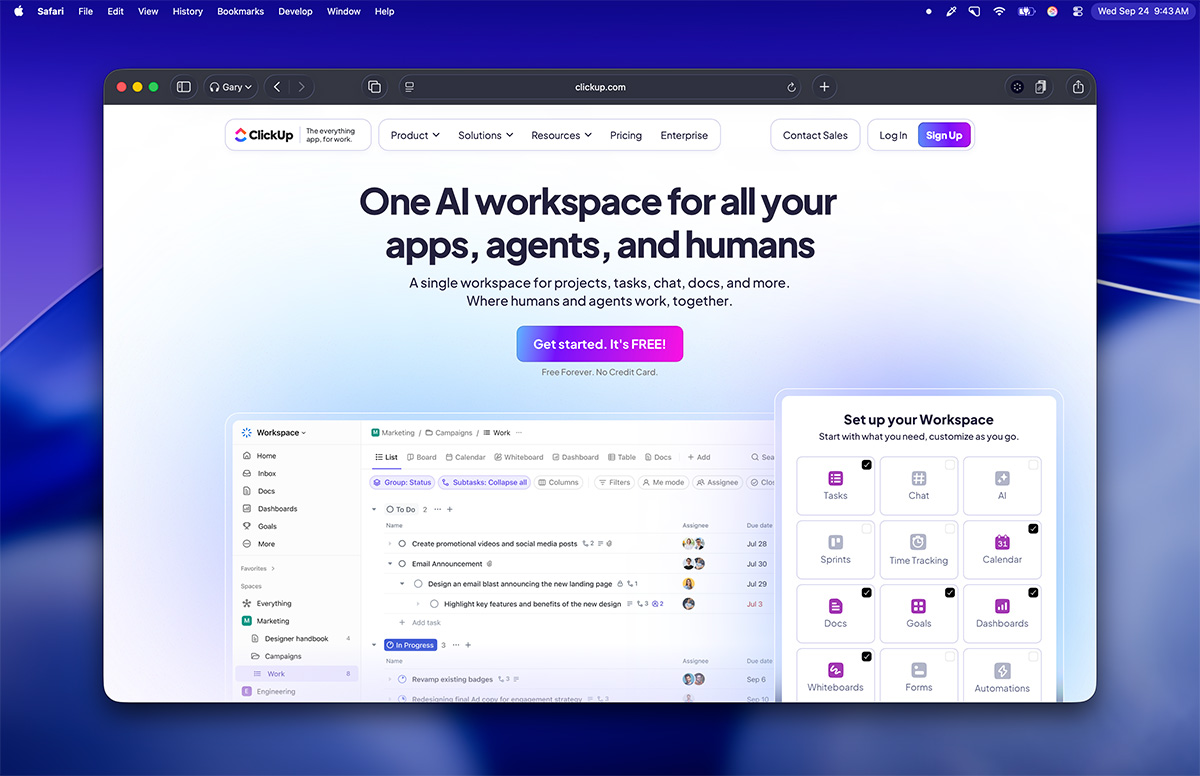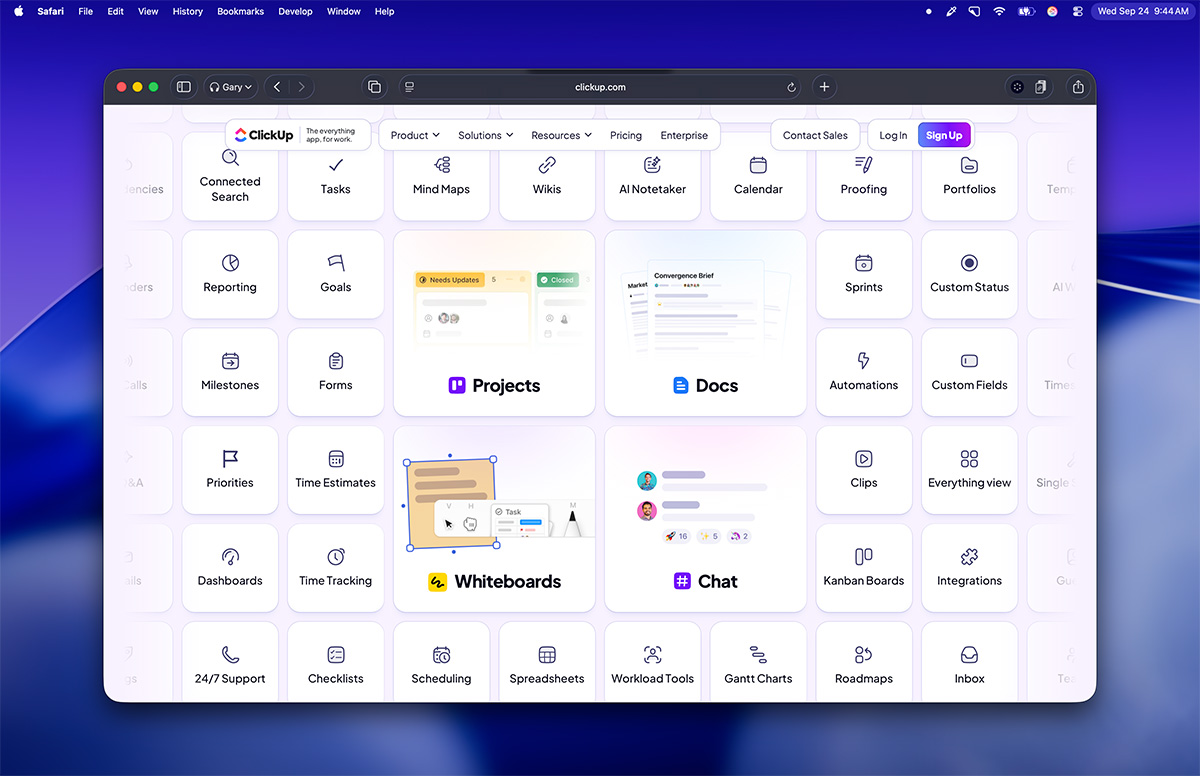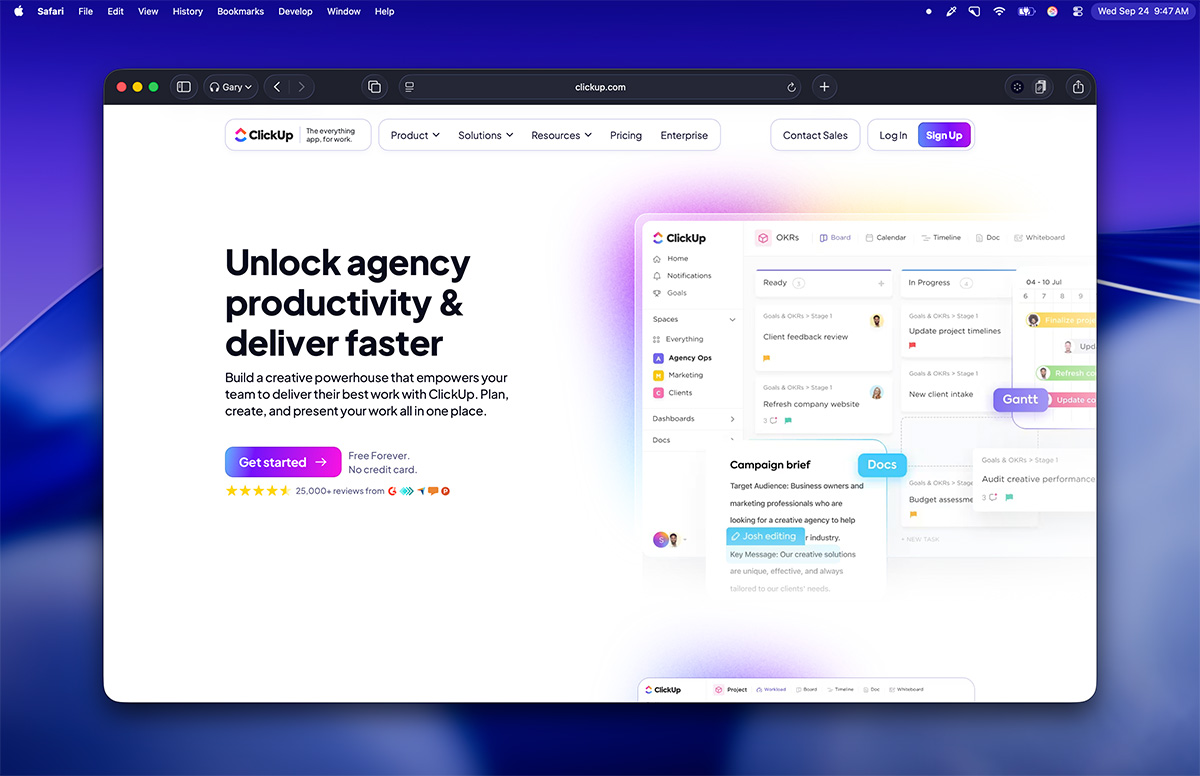
ClickUp at Big Pixel: Where Dev, Design, and Clients Work in the Same Rhythm
Software projects rarely collapse because the team forgot how to code or design. They stumble when work gets split across tools and stops telling a single story. A designer updates a flow but it never makes it to the sprint board.
A developer builds against last week’s spec because the revision lived in someone’s inbox. Marketing schedules a launch before QA has cleared the release.
Each of these breakdowns is small. Together, they drag a project into the kind of chaos that burns trust.
We refuse to run the business that way. ClickUp is where we deliberately pull development, design, marketing, and clients into one rhythm so nothing gets siloed. It’s not flawless, but it’s the only platform we’ve found that lets a designer’s decision become a developer’s task, that lets QA’s notes become fixes, and that gives clients a real-time view of progress.
As ClickUp evolves, we adopt what strengthens that rhythm and ignore what doesn’t.
We believe that business is built on transparency and trust. We believe that good software is built the same way.

Why ClickUp Works for Companies Like Ours
Running a software design and development shop means juggling dev tickets, design assets, marketing campaigns, client communication, and internal ops all at once. Left in separate tools, those threads unravel.
What makes ClickUp powerful for us is how it lets every part of the business — technical, creative, and client-facing — live in one system without losing clarity.
Here’s how that plays out inside Big Pixel:
Unified Workspace
Instead of scattering truth across five different platforms, we anchor everything in ClickUp. A single task can hold the Figma frame, the acceptance criteria, QA notes, and the marketing go-live plan. That keeps everyone aligned on one version of reality.
Flexible Structure, Shared Views
We build our hierarchy the same way we work: Spaces for the big buckets, Folders and Lists for projects, and Tasks for the work itself. Developers pull momentum from Board view, designers manage deliverables in List, PMs plan dependencies in Timeline, and clients see progress through Dashboards. It’s the same data, presented through the lens each group needs.
Automation That Reduces Drag
ClickUp handles the admin load we used to burn hours on. Status changes trigger assignments, dependencies adjust schedules, and recurring reminders fire automatically. It’s all about removing the small frictions that slow teams down.
Context That Travels With the Work
Design feedback lives on the task, not in a screenshot thread. Dev questions become subtasks with owners and dates. QA bugs aren’t on a separate sheet; they’re tasks tied to the release. When context stays where the work is, people stop chasing clarity and just execute.
Time and Budget Visibility
Fixed-fee projects demand early truth-telling. By tracking estimates and actuals at the task level and rolling them into dashboards, we see burn vs. scope in real time. That visibility lets us adjust before issues become surprises.
Client-Friendly Communication
Clients don’t need the chatter — they need the picture. A shared dashboard shows milestones, blockers, and what shipped recently. It replaces static status reports with live progress, giving clients confidence without asking the team to perform updates.
Big Pixel isn’t alone in using ClickUp this way.
Agencies like Hawke Media report stronger collaboration and execution after centralizing in ClickUp — a dynamic we’ve mirrored with our own clients when they log in and see the same source of truth we use.
And when a platform is trusted by global players like IBM and DHL, it validates that aligning complex, cross-functional work in one system isn’t a nice-to-have. It’s how modern teams scale without losing clarity.
That’s why it fits here.
ClickUp isn’t just another app on the stack. It’s the place where developers and designers converge, where marketing campaigns tie to real deliverables, and where clients share the same window we do.

The Discipline That Keeps ClickUp Useful
A powerful platform without guardrails turns into noise.
We’ve learned to keep the system lean on purpose: a clean hierarchy, a small set of approved views, quarterly audits to retire fields and statuses that crept in during busy seasons.
And because we run fixed-fee projects, time and scope aren’t optional.
Estimates live at the task level and roll up to the List. Actuals are logged where the work happens. Budget burn vs. scope sits on a dashboard we all look at — the place we catch a trend before it becomes a problem.
It’s about truth-telling early enough to make better choices.

What the Newest Updates Change
The best updates don’t reinvent the process; they remove friction. The recent ones we’ve adopted do exactly that.
A client review used to mean someone scribbled notes while trying to lead the meeting. Now ClickUp’s AI Notetaker captures the conversation, pulls decisions and action items, and drops the right tasks where they belong.
The moment the call ends, follow-ups exist in the system that runs the work — not in a heroic recap.
Scheduling used to be the place momentum quietly died: a dependency moved and the timeline didn’t, at least not everywhere.
The recent scheduling improvements — duration handling, skipping weekends automatically, a clearer Workload view with faster performance — mean our plans match reality sooner, and capacity issues surface while we can still fix them.
Design workshops are easier to run when the tool gets out of the way.
Whiteboards are less fussy now — arrows that actually cooperate, grouping that behaves, sticky notes you can size without a fight. When we map a customer journey with a client, we stay in the flow instead of troubleshooting the canvas.
Calendar collisions are an old enemy. Bringing Outlook events into ClickUp’s calendar means the day we promised to ship won’t accidentally land on top of a client summit.
Time blocking a task into a real schedule is a small, humane move that rescues focus in a meeting-heavy week.
None of these changes transform how we work. They protect it.
They shorten the gap between a decision and a task. They keep plans honest. They make the shared picture easier to see.

Where Teams Go Wrong
Most ClickUp failures we encounter look the same: every team invents its own statuses and fields, everyone builds their own views, and onboarding becomes tribal knowledge.
People stop trusting the system because there is no system — just a platform shape-shifting by person.
We keep ours boring on purpose. Standard names. A limited set of statuses that mirror the real lifecycle of work here.
Comments that become subtasks when they require a date and an owner. Docs linked to tasks, not floating around as “final_final_v7.”
The boring stuff is the brave stuff; it’s how you build a place where creative, technical people can move fast without stepping on each other.
We don’t keep ClickUp because it’s trendy; we keep it because it closes the gap between intention and delivery.
It lets design decisions become development work without friction. It turns conversations into tasks without a transcription tax. It keeps schedules honest and calendars respectful. It gives clients the same window we use.
It doesn’t make the work easier. It makes the work clearer. And that’s the only way teams like ours stay healthy while shipping real things.
We believe that business is built on transparency and trust. We believe that good software is built the same way.
That’s the bar we hold our tools to. Right now, ClickUp clears it.

ClickUp at Big Pixel: Where Dev, Design, and Clients Work in the Same Rhythm
Software projects rarely collapse because the team forgot how to code or design. They stumble when work gets split across tools and stops telling a single story. A designer updates a flow but it never makes it to the sprint board.
A developer builds against last week’s spec because the revision lived in someone’s inbox. Marketing schedules a launch before QA has cleared the release.
Each of these breakdowns is small. Together, they drag a project into the kind of chaos that burns trust.
We refuse to run the business that way. ClickUp is where we deliberately pull development, design, marketing, and clients into one rhythm so nothing gets siloed. It’s not flawless, but it’s the only platform we’ve found that lets a designer’s decision become a developer’s task, that lets QA’s notes become fixes, and that gives clients a real-time view of progress.
As ClickUp evolves, we adopt what strengthens that rhythm and ignore what doesn’t.
We believe that business is built on transparency and trust. We believe that good software is built the same way.

Why ClickUp Works for Companies Like Ours
Running a software design and development shop means juggling dev tickets, design assets, marketing campaigns, client communication, and internal ops all at once. Left in separate tools, those threads unravel.
What makes ClickUp powerful for us is how it lets every part of the business — technical, creative, and client-facing — live in one system without losing clarity.
Here’s how that plays out inside Big Pixel:
Unified Workspace
Instead of scattering truth across five different platforms, we anchor everything in ClickUp. A single task can hold the Figma frame, the acceptance criteria, QA notes, and the marketing go-live plan. That keeps everyone aligned on one version of reality.
Flexible Structure, Shared Views
We build our hierarchy the same way we work: Spaces for the big buckets, Folders and Lists for projects, and Tasks for the work itself. Developers pull momentum from Board view, designers manage deliverables in List, PMs plan dependencies in Timeline, and clients see progress through Dashboards. It’s the same data, presented through the lens each group needs.
Automation That Reduces Drag
ClickUp handles the admin load we used to burn hours on. Status changes trigger assignments, dependencies adjust schedules, and recurring reminders fire automatically. It’s all about removing the small frictions that slow teams down.
Context That Travels With the Work
Design feedback lives on the task, not in a screenshot thread. Dev questions become subtasks with owners and dates. QA bugs aren’t on a separate sheet; they’re tasks tied to the release. When context stays where the work is, people stop chasing clarity and just execute.
Time and Budget Visibility
Fixed-fee projects demand early truth-telling. By tracking estimates and actuals at the task level and rolling them into dashboards, we see burn vs. scope in real time. That visibility lets us adjust before issues become surprises.
Client-Friendly Communication
Clients don’t need the chatter — they need the picture. A shared dashboard shows milestones, blockers, and what shipped recently. It replaces static status reports with live progress, giving clients confidence without asking the team to perform updates.
Big Pixel isn’t alone in using ClickUp this way.
Agencies like Hawke Media report stronger collaboration and execution after centralizing in ClickUp — a dynamic we’ve mirrored with our own clients when they log in and see the same source of truth we use.
And when a platform is trusted by global players like IBM and DHL, it validates that aligning complex, cross-functional work in one system isn’t a nice-to-have. It’s how modern teams scale without losing clarity.
That’s why it fits here.
ClickUp isn’t just another app on the stack. It’s the place where developers and designers converge, where marketing campaigns tie to real deliverables, and where clients share the same window we do.

The Discipline That Keeps ClickUp Useful
A powerful platform without guardrails turns into noise.
We’ve learned to keep the system lean on purpose: a clean hierarchy, a small set of approved views, quarterly audits to retire fields and statuses that crept in during busy seasons.
And because we run fixed-fee projects, time and scope aren’t optional.
Estimates live at the task level and roll up to the List. Actuals are logged where the work happens. Budget burn vs. scope sits on a dashboard we all look at — the place we catch a trend before it becomes a problem.
It’s about truth-telling early enough to make better choices.

What the Newest Updates Change
The best updates don’t reinvent the process; they remove friction. The recent ones we’ve adopted do exactly that.
A client review used to mean someone scribbled notes while trying to lead the meeting. Now ClickUp’s AI Notetaker captures the conversation, pulls decisions and action items, and drops the right tasks where they belong.
The moment the call ends, follow-ups exist in the system that runs the work — not in a heroic recap.
Scheduling used to be the place momentum quietly died: a dependency moved and the timeline didn’t, at least not everywhere.
The recent scheduling improvements — duration handling, skipping weekends automatically, a clearer Workload view with faster performance — mean our plans match reality sooner, and capacity issues surface while we can still fix them.
Design workshops are easier to run when the tool gets out of the way.
Whiteboards are less fussy now — arrows that actually cooperate, grouping that behaves, sticky notes you can size without a fight. When we map a customer journey with a client, we stay in the flow instead of troubleshooting the canvas.
Calendar collisions are an old enemy. Bringing Outlook events into ClickUp’s calendar means the day we promised to ship won’t accidentally land on top of a client summit.
Time blocking a task into a real schedule is a small, humane move that rescues focus in a meeting-heavy week.
None of these changes transform how we work. They protect it.
They shorten the gap between a decision and a task. They keep plans honest. They make the shared picture easier to see.

Where Teams Go Wrong
Most ClickUp failures we encounter look the same: every team invents its own statuses and fields, everyone builds their own views, and onboarding becomes tribal knowledge.
People stop trusting the system because there is no system — just a platform shape-shifting by person.
We keep ours boring on purpose. Standard names. A limited set of statuses that mirror the real lifecycle of work here.
Comments that become subtasks when they require a date and an owner. Docs linked to tasks, not floating around as “final_final_v7.”
The boring stuff is the brave stuff; it’s how you build a place where creative, technical people can move fast without stepping on each other.
We don’t keep ClickUp because it’s trendy; we keep it because it closes the gap between intention and delivery.
It lets design decisions become development work without friction. It turns conversations into tasks without a transcription tax. It keeps schedules honest and calendars respectful. It gives clients the same window we use.
It doesn’t make the work easier. It makes the work clearer. And that’s the only way teams like ours stay healthy while shipping real things.
We believe that business is built on transparency and trust. We believe that good software is built the same way.
That’s the bar we hold our tools to. Right now, ClickUp clears it.



